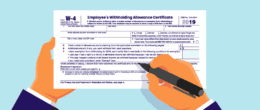The Improved Form W-4: How it Affects Your Tax Refund


File your taxes with confidence.
Your max tax refund is guaranteed.
Most employees are familiar with Form W-4, which instructs your employer on how much tax to withhold from your paycheck. This form received a major redesign at the start of 2020, making it very different from what many taxpayers were used to.
To some, the form may seem a bit overwhelming. But, in reality, it is now much more straightforward. Let’s take a look at what changed on the W-4 form from 2020 onward and what these changes mean for your income tax withholdings.
What is Form W-4?
First, let’s recap what this form is and why it’s important. Form W-4 tells your employer how much federal income tax to withhold from your paycheck every pay period. Using the information you provided when filling out the form, your employer will determine how much tax to withhold from each paycheck.
Your W-4 form has a lot of power over your taxes — if your employer withholds more income tax than you owe, you will receive a bigger tax refund when you file. If your employer doesn’t withhold enough, you might find yourself stuck with a tax bill at the end of the tax year.
On the old form, you could claim allowances on your W-4 to lower the amount of federal income tax withheld from your paychecks. As a result, many people got used to the idea that the number of allowances they claimed controlled how much income tax was taken out of their wages, allowing them to better control whether or not they received a big refund.
Why was it changed?
The Tax Cuts and Jobs Act of 2017 overhauled the nation’s federal income tax code, adjusting a system that had been in place for decades. The law got rid of personal exemptions and drastically increased the standard deduction, nearly doubling it. As of 2023, the standard deduction for single filers is $13,850 ($27,700 for joint filers). This standard deduction increase led to many more Americans electing to take the standard deduction rather than itemize their deductions, essentially removing the need for withholding allowances.
To accommodate these tax law revisions, the IRS made some significant changes to the W-4 in 2020. Today’s withholding form is arguably less confusing than its predecessor — it’s simple, straightforward, and designed to create the most accurate withholding for all employees. Ideally, this improved accuracy means your tax bill (or your tax refund amount) will be as close to zero as possible when you file your tax return.
What exactly changed on the W-4 form?
Form W-4 still requires you to provide typical identifying information, such as your name, address, Social Security number, and filing status. Beyond that, the rest of the form looks very different than any W-4 you may have filled out prior to 2020.
The withholding form went from a half page to a full page, with up to five sections for taxpayers to fill out depending on their tax situation. While a full page might seem daunting, the expansion of Form W-4 is designed to be more user-friendly and easier for taxpayers to understand.
How do I fill out my W-4 form?
When filling out your W-4 form, you only need to complete the sections that apply to you.
We’ve listed the improved five-step process (and what each section entails) below:
- Personal information – This section asks you to provide your name, address, Social Security number, and filing status.
- Multiple jobs – If you have more than one job OR you are a joint filer with a working spouse, you will need to fill out this section. To ensure you don’t end up with a tax bill, it’s important that you accurately estimate all additional sources of income, so your withholdings correctly align with your tax liability.
- Claiming dependents – This section allows you to claim any dependents, ensuring the Child Tax Credit is deducted from your withholding. Fill out this section if you are the sole earner, or if you are married filing jointly and have the highest-paying job. If you are single with multiple jobs, you would also only need to fill out this section for your highest paying job.
- Other adjustments – This section gives you more options to ensure your withholdings are accurate. If you have other income (capital gains, freelancing, interest, dividends, etc.) you can add additional withholding here to help cover those taxes. If you itemize your deductions, you can add extra deductions in this section. And if you want to add extra withholding you can choose to do that here as well.
- Sign and date – And that’s it! Just add your signature and date the form to complete your W-4.
How do I change my withholding on Form W-4?
Changing your W-4 to get more money with your tax refund is easy. If you want to change your W-4 withholding amount — perhaps you favor receiving a bigger tax refund with your annual return — you can choose to do so on line 4(c) of the W-4 form.
How can I make changes to my W-4 form, and should I change my withholding?
You are allowed to update your Form W-4 at any time; just ask your HR or payroll department if you wish to do so. Many employers provide an easy way to change your W-4 online, or you can also print the form directly from the IRS website. The IRS W-4 form also provides taxpayers with a Multiple Jobs Worksheet and a Deductions Worksheet to help you calculate an accurate withholding if these circumstances apply to you.
It’s always a good idea to review and adjust your W-4 withholding after major life events that may impact your tax liability such as getting married, having a child, or receiving a big raise.
The bottom line
The improved W-4 form was designed to demystify income tax withholdings for taxpayers, but if your tax situation is particularly complex, you may benefit from checking out the IRS’s Tax Withholding Estimator. This handy tool can help you decide if you need to make any changes to your W-4 withholding.
But, if you are happy with your tax outcome, then there’s no need to change a thing.





